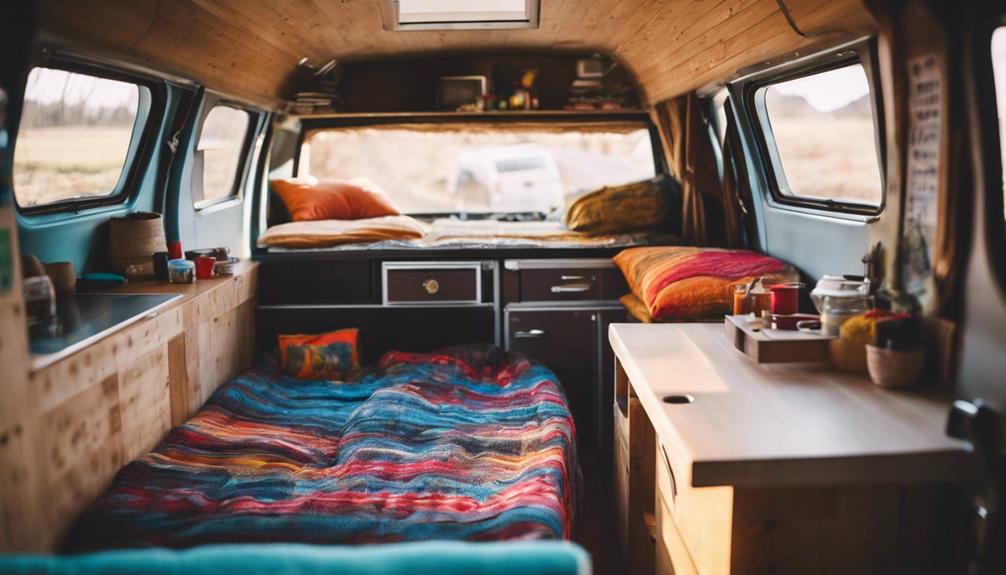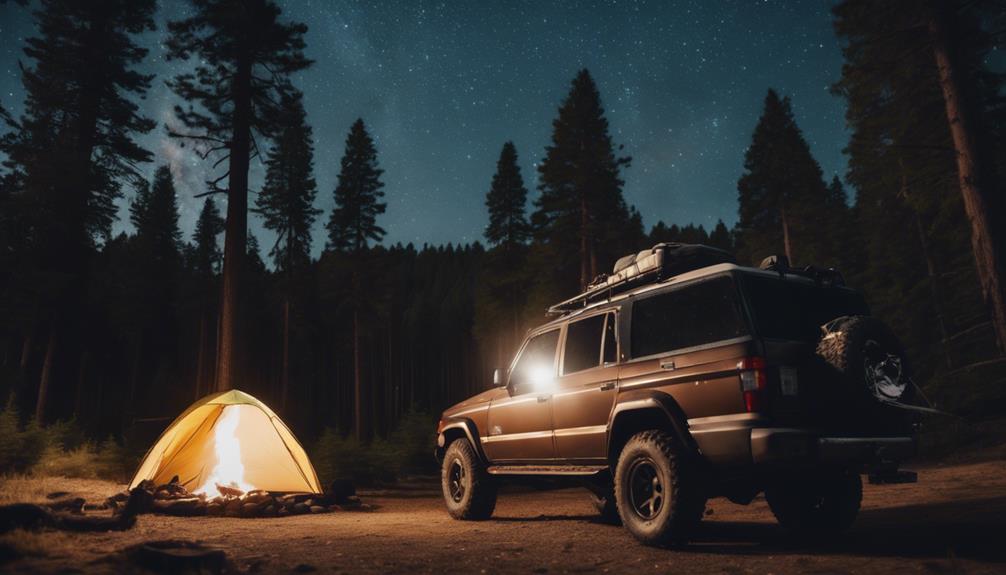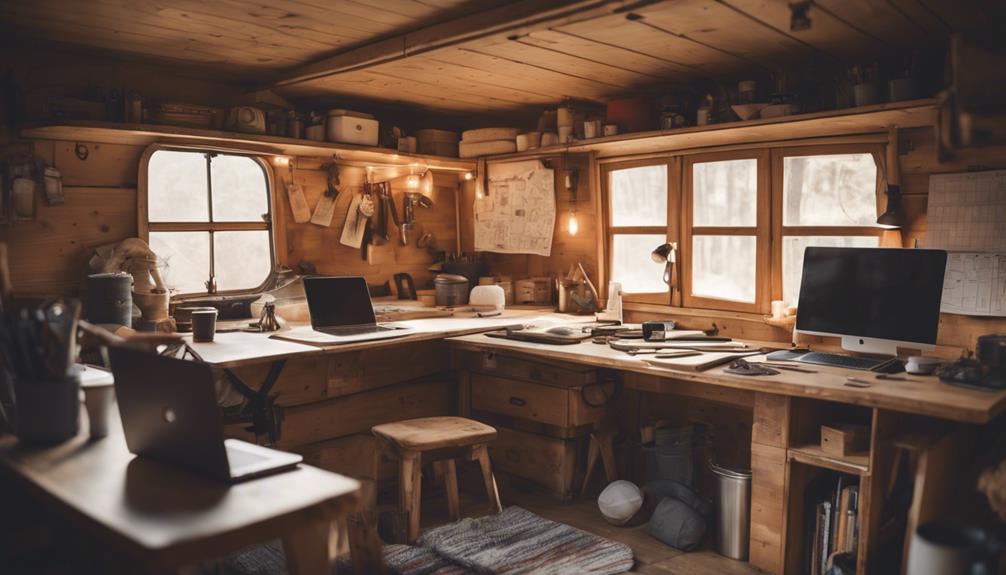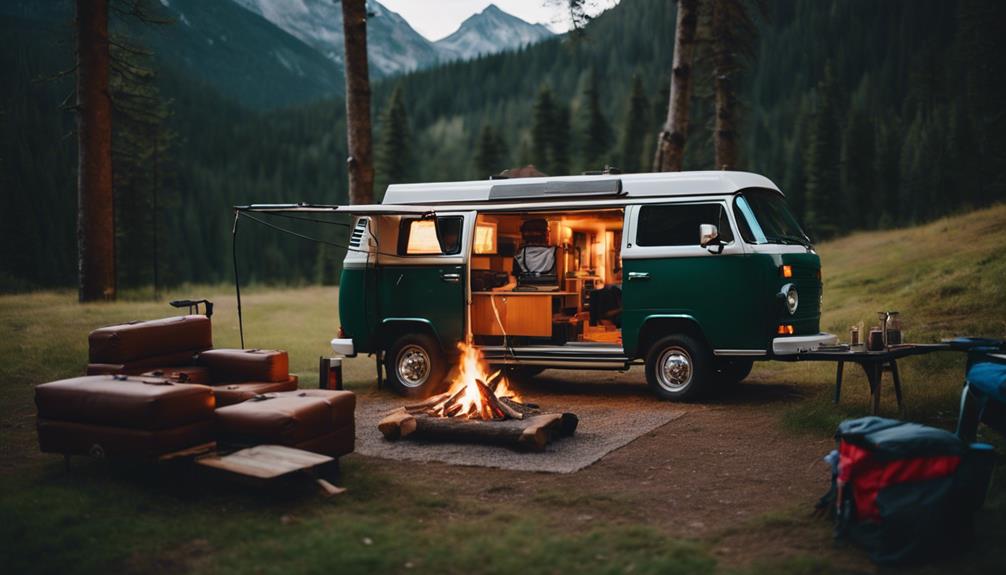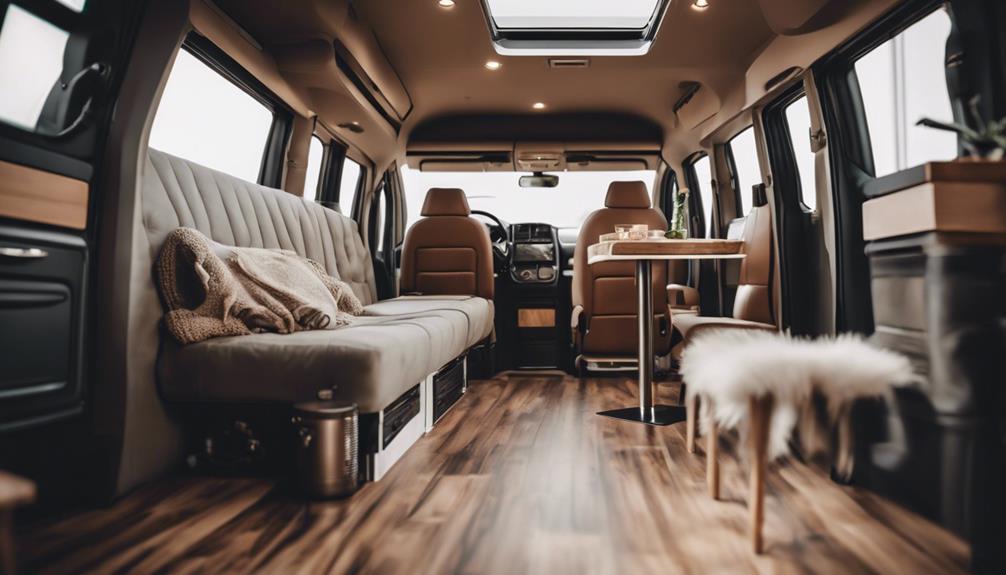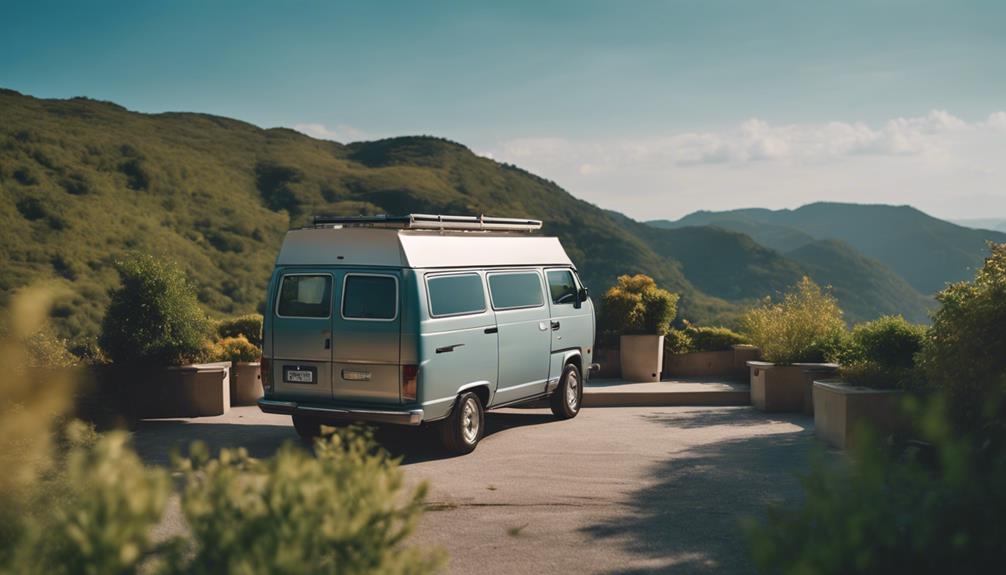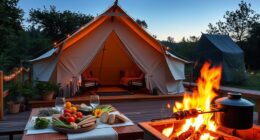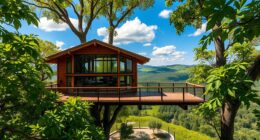You can easily transform your van into a budget-friendly camper for around $1,000 using DIY strategies. Start by prioritizing essential features like insulation and storage over luxury items. Look for scrap materials and second-hand furniture on platforms like Craigslist or thrift stores to cut costs. Simple solutions like camp stoves and air mattresses can provide comfort without breaking the bank. Keep functionality at the forefront with multi-use furniture and efficient layouts. With smart planning and creativity, you can create a practical living space. Stick around for more tips and innovative ideas to elevate your camper conversion journey.
Introduction
If you're looking to hit the road without breaking the bank, a budget camper conversion could be your perfect solution. With some creativity and a DIY spirit, you can transform your vehicle into a cozy getaway for as low as $1,000.
Start by prioritizing essential features like insulation and storage, which are vital for comfort on your adventures. Utilizing scrap materials and second-hand items from platforms like Craigslist or local thrift stores can help you save considerably.
Instead of a full kitchen, consider a camp stove for cooking and a cooler for food storage; these budget-friendly options work just as well. For sleeping arrangements, camping mats or air mattresses offer comfort without the hefty price tag of custom solutions.
To make the most of your limited space, you can use planning tools like Vanspace 3D to visualize your layout. This way, you can maximize storage and guarantee your camper conversion meets all your needs without overspending.
Embrace the DIY approach, and you'll find that building your dream camper doesn't have to be expensive—it can be fun and rewarding, too!
Background Information
The vanlife movement took off as a way for people to embrace adventure and simplicity, making it easier than ever to hit the road.
As minimalist designs gained popularity, many started focusing on essential features rather than excess, leading to more budget-friendly options.
Understanding these origins can help you appreciate the freedom and creativity behind your own camper conversion.
Vanlife Movement Origins
Emerging from the counterculture of the late 1960s and early 1970s, the vanlife movement embodies a quest for freedom and adventure, attracting those who seek a nomadic lifestyle. Early vanlifers modified Volkswagen buses, creating budget campers that became iconic symbols of this movement. These conversions fostered a sense of community and shared travel experiences among like-minded individuals.
Today, the resurgence of the vanlife movement is notably influenced by social media platforms, where you can find countless affordable DIY van camper conversions and tips. Many people are drawn to this lifestyle as they embrace a minimalist lifestyle, prioritizing experiences over possessions. A 2020 survey revealed that about 1 in 4 millennials are interested in living the vanlife, highlighting its appeal among younger generations.
Sustainability is a core principle of the movement; vanlifers often choose eco-friendly materials and practices for their conversions. By living in a van, you can reduce your carbon footprint while exploring nature and enjoying the freedom of the open road.
This blend of adventure, community, and eco-consciousness defines the essence of the vanlife movement.
Emergence of Minimalist Designs
Embracing minimalist designs in camper van conversions focuses on maximizing functionality and simplicity, making the most of limited space. You can create a practical living environment by using efficient layouts that promote easy movement and accessibility. This approach often involves incorporating multi-use furniture, allowing you to adapt your space for various activities without adding clutter.
Using DIY techniques and second-hand materials not only cuts costs but also supports sustainable practices. You can find unique pieces that add character while contributing to a greener lifestyle. Essential amenities like a compact kitchen and sleeping area are prioritized, ensuring you have what you need without the luxury excess.
The trend toward minimalist designs aligns perfectly with the vanlife movement, encouraging you to prioritize experiences over material possessions. By focusing on efficient storage solutions, you can keep your essentials organized and accessible, enhancing your overall living experience.
Ultimately, this minimalist approach fosters a sense of freedom and adventure, allowing you to travel light and explore the world without being weighed down by unnecessary items. This way, you'll enjoy both functionality and simplicity in your camper conversion.
Recent Van Conversion Innovations
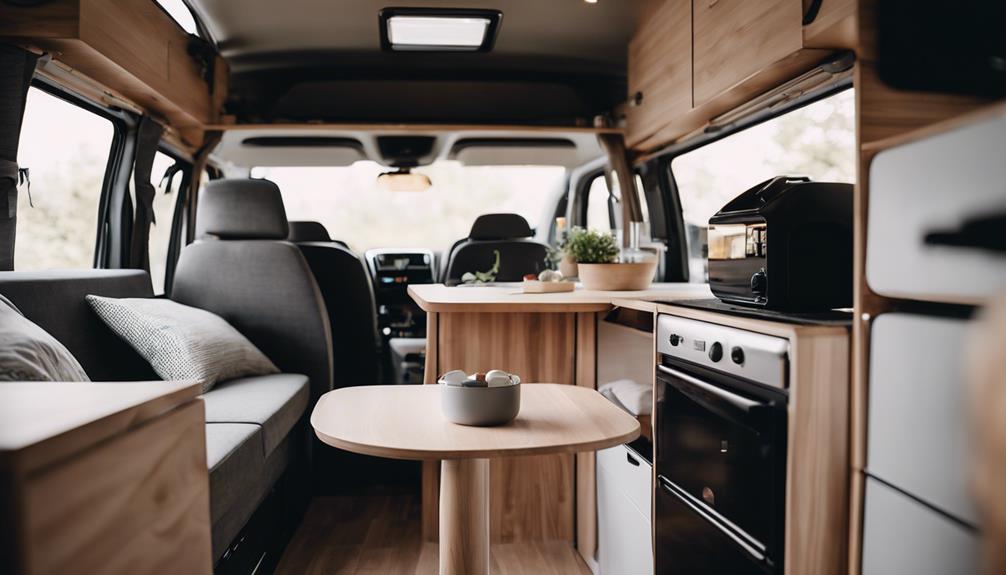
When you tackle a van conversion, you'll notice innovative space-saving designs that make the most of every inch.
Plus, using sustainable materials like reclaimed wood not only boosts the aesthetic but also helps the environment.
These recent advancements are changing the game for budget-friendly camper conversions.
Sustainable Materials in Conversions
Recent van conversion innovations focus on sustainable materials like bamboo, reclaimed wood, and recycled composites, which not only enhance durability but also reduce environmental impact.
In your DIY van build, opting for eco-friendly insulation materials, such as wool or denim, can greatly improve thermal efficiency while being biodegradable. This choice is a great alternative to traditional fiberglass insulation.
Additionally, consider using low-VOC paints and finishes in your conversion. These options promote better indoor air quality and minimize harmful emissions, making your van a healthier living space.
Integrating solar panels made from recycled materials is another innovative step toward sustainability. This solution not only provides renewable energy but also decreases your reliance on fossil fuels, enhancing your off-grid living experience.
Moreover, you can incorporate modular furniture crafted from sustainably sourced materials. This approach maximizes space efficiency and reduces waste during the conversion process.
By focusing on these sustainable materials, you'll create a comfortable, eco-friendly van that reflects your values while providing a functional living space.
Embrace these innovations, and enjoy the benefits of a greener lifestyle on the road.
Innovative Space-Saving Designs
Innovative space-saving designs in van conversions allow you to maximize functionality and comfort, making the most of limited living areas. By incorporating modular furniture designs, you can easily reconfigure your space, transforming it from a cozy living area to a dining spot with minimal effort.
Foldable components, like tables and beds, enhance space efficiency, allowing you to adjust your setup based on your needs. Using lightweight materials such as aluminum and composite panels not only reduces weight but also improves fuel efficiency, making your travels easier.
Integrated storage solutions, including under-bed drawers and ceiling-mounted racks, help you stay organized without sacrificing floor space. Moreover, advancements like spray foam insulation create energy-efficient environments, ensuring your campervan remains temperature-regulated. This enhances your comfort in both hot and cold weather.
These innovative designs and materials work together to optimize every inch of your van, providing you with a practical yet comfortable living space. So, whether you're on a weekend getaway or a long road trip, you'll appreciate the smart use of space that innovative designs bring to your camper conversion.
User Experiences and Feedback
When considering a budget camper conversion, you'll want to weigh the benefits and drawbacks based on real user experiences.
Insights from campervan experts can guide your decisions on cost versus functionality, helping you make the most of your budget.
Let's explore how others have navigated their conversions and what you can learn from their journeys.
Benefits and Drawbacks
DIY camper conversions offer significant cost savings and the chance to create a personalized living space, but they come with their own set of challenges that users have experienced firsthand.
Opting for a DIY campervan conversion can help you save money and declutter your life, with total costs averaging between $1,000 and $3,500, compared to professional builds that can exceed $30,000. Many users emphasize the importance of focusing on essential features, like insulation and creative storage solutions, while forgoing luxuries to stay within budget.
Sourcing second-hand materials is a popular strategy among DIYers, as it not only reduces costs but also sparks creativity in design. However, building a budget and sticking to it can be difficult, as the process often involves a lot of trial and error.
While the labor-intensive nature of a DIY project can be intimidating, the satisfaction of creating an affordable camper van that meets your needs is worth the effort. Ultimately, users find that the benefits of crafting a personalized living space—tailored to their travel style—outweigh the initial hurdles they face during the conversion process.
Campervan Expert Insights
Expert insights from seasoned van lifers reveal that thorough market research and community engagement are key to successful budget camper conversions.
Many DIY van lifers recommend starting your journey by scouring platforms like Craigslist and Facebook Marketplace for reliable used vans, often available for as low as $1,000. This approach sets a solid foundation for your budget DIY project.
First-time builders find inspiration through resources like YouTube tutorials and Pinterest, leading to successful conversions that can be completed under $1,000. By prioritizing essential features—like insulation and storage—and opting for simpler cooking solutions, such as camp stoves, you can greatly reduce costs while maintaining livability.
Community engagement is invaluable. Joining forums and social media groups allows you to share experiences and gather creative hacks that help navigate challenges.
Feedback from travelers highlights that a functional design can evolve through gradual purchases and DIY projects, ensuring you create a comfortable living space without breaking the bank.
Cost Vs. Functionality Assessment
Balancing cost and functionality is essential for anyone looking to create a practical camper conversion without overspending. Many users successfully complete DIY camper conversions on a budget of under $1,000 by sourcing conversion materials from thrift stores and local marketplaces. This approach allows you to prioritize essential features like quality insulation and comfortable bedding, which are vital for a satisfying living experience.
Investing around $3,000 for a used van and necessary materials often strikes a perfect balance between cost and functionality. While it's tempting to splurge on luxury items, feedback from DIY van lifers suggests that functionality should take precedence. Instead of opting for full kitchen setups, many choose camp stoves and coolers, which effectively meet their needs without breaking the bank.
Ultimately, your budget campervan can still provide a comfortable and functional space by focusing on affordable solutions. Remember, the key is to prioritize what's truly necessary for your adventures. With some creativity and resourcefulness, you can achieve a successful camper conversion that meets your needs while keeping your expenses manageable.
Cost-effective Material Suggestions
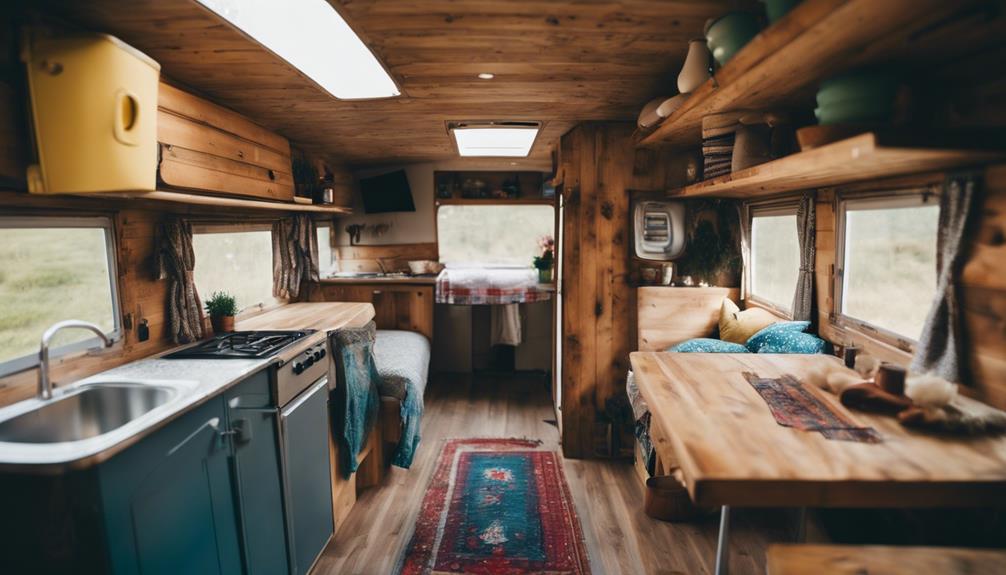
When you're planning your camper conversion, choosing the right materials can save you a lot of money without sacrificing quality.
You can explore budget-friendly design techniques and DIY options that fit your style and functional needs.
Let's look at some cost-effective material suggestions to make your project both affordable and practical.
DIY Conversion Process Overview
To keep costs down during your DIY camper conversion, consider sourcing second-hand materials from places like Craigslist and local thrift stores. This approach can greatly reduce your budget while allowing you to find unique items for your van.
For insulation, use cost-effective options like Reflectix or R15 rated safety insulation, with Reflectix typically costing around $184.96 for a standard build.
When it comes to flooring, look into luxury vinyl sheets or repurposed plywood, which provide aesthetic appeal without breaking the bank—expect to spend about $205.32 on these materials.
You can also repurpose items like pallets or scrap wood to create efficient storage solutions, maximizing space while keeping expenses low.
Don't forget about essential items for your camper conversion; a camp stove and battery-powered LED lights can provide practicality at a fraction of the cost of traditional appliances.
Budget-Friendly Design Techniques
Finding budget-friendly design techniques can elevate your camper conversion while keeping costs manageable, so consider using affordable materials that blend functionality with style.
Start by sourcing second-hand items from platforms like Craigslist or Facebook Marketplace. This way, you can find quality materials for your build at a fraction of retail prices.
Incorporate Reflectix insulation in your conversion. It's an inexpensive option, costing around $184.96 for a typical build, providing excellent thermal protection for both walls and ceilings.
For furniture and storage units, repurposing scrap wood and leftover plywood is a smart choice that minimizes waste and saves money.
When it comes to cooking, opt for a simple camp stove instead of a full kitchen setup. This not only keeps costs down but also saves valuable storage space.
Additionally, using battery-powered LED lights instead of complex electrical systems enhances energy efficiency without breaking the bank.
Can DIY Camper Conversions be as Affordable as Budget Options?
Looking to save money on your camper conversion project? With the right camper conversion DIY tutorial, you can definitely achieve an affordable outcome. By opting for a budget-friendly DIY approach, you can customize your camper exactly to your needs without breaking the bank.
What are the Best Affordable DIY Solutions for Camper Conversion Using Durable and Lightweight Wood?
Looking for budget-friendly camper conversion options? Consider using durable, lightweight wood for camper renovations. Opt for plywood or engineered wood for framing, cabinets, and paneling to keep weight down. These materials offer long-lasting performance, making them great for DIY camper projects on a budget.
Conclusion
Achieving a budget-friendly camper conversion is entirely possible with careful planning and resourcefulness. By focusing on essential features and utilizing scrap materials, you can create a comfortable living space without breaking the bank.
DIY solutions, like using recycled items for storage and choosing a camp stove instead of a full kitchen, help keep costs low while ensuring functionality.
Insulating the van with affordable materials, such as Reflectix and foam board, is vital for comfort, especially in varying weather conditions. Tracking expenses throughout the conversion process will help you manage your budget effectively, keeping your total build around $3,000 to $4,000, depending on your choices.
Engaging with van life communities can provide invaluable insights into cost-effective builds and creative ideas for maximizing limited space. You'll find support and inspiration from fellow enthusiasts who share your passion for affordable camper living.
Remember, while it may seem overwhelming, your dream of a budget camper conversion is within reach. With the right approach and a bit of ingenuity, you can create a space that meets your needs without overspending.
Embrace the journey, and enjoy the freedom of van life!
Frequently Asked Questions
How Much Does a DIY Campervan Conversion Cost?
A DIY campervan conversion typically costs between $1,000 and $4,082. By using second-hand materials and focusing on essential features, you can keep expenses down while creating a comfortable, personalized space for your adventures.
What Is the Best Budget Van to Convert to Camper?
When you're choosing a budget van to convert into a camper, consider options like the Ford Transit Connect, Chevy G20, or Dodge Ram Van for their affordability, space, and reliability. They'll meet your needs well.
What Is the Cheapest Van to Turn Into a Camper?
If you're looking for the cheapest van to turn into a camper, consider the 1994 Chevy G20. You can often find it for around $2,000, making it a great budget-friendly option for conversions.
Is It Cheaper to Build Your Own Camper?
Yes, it's cheaper to build your own camper. By using scrap materials and focusing on essential features, you can greatly cut costs, making DIY conversions an affordable option compared to professional ones.
Conclusion
To summarize, you can create an affordable camper conversion that fits your budget and lifestyle.
By exploring innovative ideas and cost-effective materials, you'll not only save money but also enjoy the satisfaction of a DIY project.
Don't forget to take into account user experiences, as they can provide valuable insights.
With a bit of creativity and planning, you can hit the road in a cozy, functional camper that reflects your personal style without breaking the bank.

